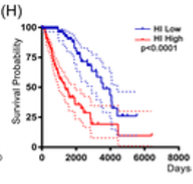Sequencing of glioma brain tumors sometimes identifies sequences from human herpesviruses, including HHV-6A/B and HHV-7. HHV-6 DNA and protein have been found in glioma tissues. Scientists from the Sichuan Academy of Medical Sciences in China analyzed nucleic acid sequencing data from 513 people with gliomas and found HHV-6A/B and/or HHV-7 DNA and mRNA in 24. Information on the clinical course of the gliomas was available for analysis.
Multivariate analysis found that five differentially expressed viral genes predicted a better vs. a worse outcome in the initial “training” set of glioma samples and in two validation sets.

Figure – Survival curves in glioma patients. Survival shown in blue (solid line mean value, dotted lines indicate confidence interval) represents those patients with the gene expression signature of a relatively better prognosis, and survival shown in red represents those patients with the signature of a relatively worse prognosis.
The gene expression signature also predicted the response vs. non-response to the main current treatment for glioma, temozolomide. Finally, the gene expression signature that indicates a relatively good prognosis was found in tumor cell-lines established from the tumors of treatment responders and the signature for poor prognosis was found in cell lines established from the tumors of treatment non-responders.
It is unclear if the multivariate analysis of the prognostic value of the viral gene expression pattern included host genes that could affect prognosis, and therefore if the viral gene signature had independent prognostic value. Finally, this analysis does not provide evidence that either HHV-6A/B or HHV-7 play a causal role in glioma.
Read the full article: Chen 2022

